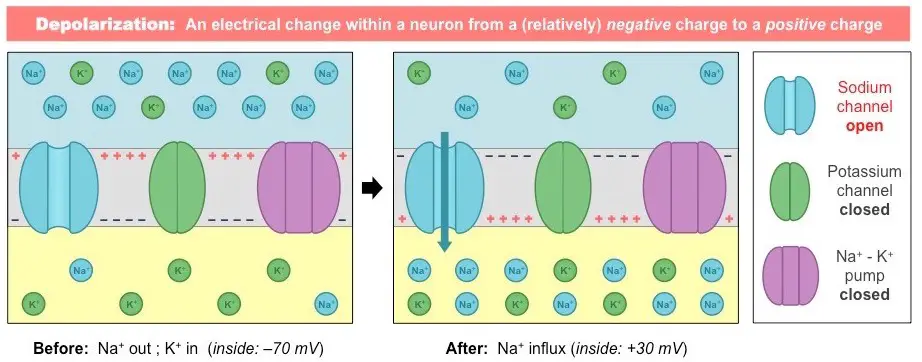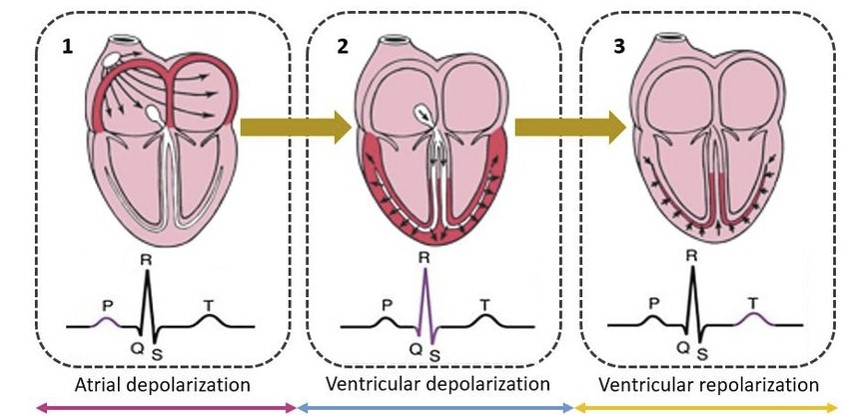The human body operates through a complex system of electrical signals, especially evident in the functioning of the heart and nervous system. These electrical activities, crucial for life, are governed by processes known as depolarization and repolarization. Each plays a vital role in how cells communicate and perform, marking the foundation of every heartbeat and nerve impulse.
Depolarization and repolarization are fundamental to the action potential of neurons and muscle cells, including those in the heart. Depolarization is the process by which cells become more positive, leading to the activation of a nerve impulse or muscle contraction. Repolarization, conversely, is the return of the cell to its resting negative state, readying it for the next signal. The orchestrated sequence of these processes ensures the proper functioning of our body’s electrical systems.
Understanding the precise mechanisms of depolarization and repolarization sheds light on their importance in health and disease. Abnormalities in either process can lead to serious conditions such as arrhythmias or neurological disorders, highlighting the need for detailed knowledge of these electrical phenomena. This foundational understanding is not just crucial for medical professionals but also enhances our appreciation of the body’s intricate design.

Basics of Electrical Activity
Cell Membrane Potential
Definition and Significance
The cell membrane potential is a vital electrical charge difference across the cell’s membrane. This difference is crucial for the cell’s survival and function, affecting how cells communicate and respond to their environment. It is the foundation of all neural and muscular activities in the body, including the heart’s rhythm and the brain’s information processing.
Role of Ions
Ions like sodium (Na+), potassium (K+), and calcium (Ca2+) are pivotal in creating and maintaining the cell membrane potential. Each ion has a specific role:
- Sodium (Na+) ions, when entering the cell, make the inside more positive, affecting the membrane potential directly.
- Potassium (K+) ions have a contrasting role, moving out of the cell to restore a negative charge inside.
- Calcium (Ca2+) ions influence various cellular activities, including muscle contractions and neurotransmitter release.
Depolarization
Definition
Depolarization is the process where the cell membrane’s electrical charge becomes less negative compared to the outside. This change is critical for initiating action potentials in neurons and muscle cells.
Mechanism
The mechanism of depolarization involves:
- Opening of sodium channels: This allows Na+ ions to rush into the cell, making the inside more positive.
- Ionic shifts: The movement of ions changes the membrane’s potential, leading to depolarization.
Role in Action Potential
Depolarization serves as the trigger for action potentials, the electrical impulses that neurons use for communication. It allows for the initiation and propagation of these signals across the neuron or muscle fiber, enabling communication and response to stimuli.
Examples
- Cardiac muscle activation: Depolarization here leads to heart muscle contraction, pumping blood throughout the body.
- Neuron signaling: In neurons, depolarization facilitates the transmission of nerve impulses, crucial for brain function and reflex actions.
Repolarization
Definition
Repolarization is the process that restores the cell’s membrane potential to its resting negative state after depolarization. It is essential for preparing the cell for another round of electrical activity.
Mechanism
The key steps in repolarization include:
- Closing of sodium channels: This stops the influx of Na+ ions.
- Opening of potassium channels: K+ ions exit the cell, helping to re-establish the negative charge inside.
Role in Action Potential
Repolarization is critical for resetting the cell’s membrane potential after an action potential. It ensures that neurons and muscle cells can respond to new stimuli promptly, maintaining the body’s ability to react and function efficiently.
Examples
- Cardiac cycle phases: In the heart, repolarization marks the end of one heartbeat and prepares the heart for the next, ensuring rhythmic and continuous blood flow.
- Neuron recovery phase: After transmitting an impulse, neurons undergo repolarization to reset their membrane potential, readying themselves for the next signal.
Comparative Analysis
Key Differences
Understanding the distinctions between depolarization and repolarization is crucial for grasping how electrical signals are managed within the body. At a glance, these processes might seem like mere steps in a sequence, but their roles and effects are profoundly different.
- Depolarization involves the reduction of the membrane’s potential, making the inside of the cell more positive. This is primarily due to the influx of sodium ions (Na+).
- Repolarization restores the membrane to its resting negative state, largely through the efflux of potassium ions (K+).
These differences can be summarized as follows:
| Aspect | Depolarization | Repolarization |
|---|---|---|
| Ion Movement | Sodium ions flow into the cell | Potassium ions flow out of the cell |
| Electrical State | Membrane potential becomes less negative | Membrane potential returns to resting state |
| Role in Action Potential | Initiates the action potential | Resets the neuron for another action potential |
| Impact on Cell | Makes the cell capable of sending a signal | Prepares the cell for the next signal |
Impact on Function
The roles of depolarization and repolarization in cell communication are both distinct and complementary. Depolarization acts as the trigger for action potentials, enabling cells to send signals. Without depolarization, neurons could not transmit information, and muscles would not contract. On the other hand, repolarization is essential for resetting the cell’s state, ensuring it’s ready for subsequent signaling. This balance between activation and restoration is critical for the synchronized functions of the body, from the macro-level actions like heartbeat and thought processes to the micro-level operations within cells.
Timing and Duration
The timing and duration of depolarization and repolarization are finely tuned. Depolarization is relatively quick, as the rapid influx of sodium ions changes the cell’s state almost instantaneously, allowing for the swift initiation of action potentials. Repolarization, though also quick, is slightly slower in comparison, as it involves not just the cessation of sodium influx but also the active pumping of potassium out of the cell. This difference ensures that the cell spends an adequate amount of time in an activated state before returning to rest, a critical aspect for the proper timing of physiological responses, such as the sequential contraction and relaxation of heart muscle cells.
Clinical Significance
ECG Interpretation
The electrocardiogram (ECG) is a vital diagnostic tool in medicine, providing a graphical representation of the heart’s electrical activity. The understanding of depolarization and repolarization is essential for interpreting these traces, especially the PQRST complex, which encapsulates one complete heartbeat.
- P wave: Represents atrial depolarization, leading to atrial contraction.
- QRS complex: Denotes ventricular depolarization, which precedes ventricular contraction, and is crucial for pumping blood.
- T wave: Indicates ventricular repolarization, setting the stage for the heart to relax and then fill with blood again.
Abnormalities and Disorders
Differences in the patterns of depolarization and repolarization can lead to various cardiac and neurological disorders. For instance:
- Arrhythmias: These are irregular heartbeats arising from improper depolarization or repolarization. They can result in the heart beating too fast, too slow, or irregularly, impacting its efficiency in pumping blood.
- Epilepsy: This neurological condition, characterized by recurrent seizures, involves excessive depolarization in brain neurons. This leads to uncontrolled, synchronized firing of neurons, manifesting as seizures.
The implications of these abnormalities highlight the importance of the precise regulation and timing of depolarization and repolarization. Understanding these processes allows healthcare professionals to diagnose, treat, and manage various conditions more effectively, underscoring the significance of these electrical phenomena in both health and disease.
Frequently Asked Questions
What is Depolarization?
Depolarization is the initial change in a cell’s membrane potential that makes the interior less negative in comparison to the outside. This electrical shift is essential for the propagation of action potentials, leading to muscle contraction or nerve impulse transmission. It’s a critical step in the electrical signaling pathways that enable our hearts to beat and our neurons to fire.
How Does Repolarization Differ from Depolarization?
While depolarization involves the cell becoming more positive, repolarization is the process that restores the cell to its resting negative state. It’s essentially the cell’s way of resetting itself after an action potential, ensuring it’s ready for the next wave of electrical activity. This recovery phase is as crucial as the activation phase, maintaining the balance necessary for healthy physiological functions.
Why Are Depolarization and Repolarization Important in ECG Interpretation?
Depolarization and repolarization are vital for interpreting electrocardiograms (ECGs). They correspond to different segments of the ECG trace, with depolarization represented by the P wave and QRS complex, indicating heart muscle activation. Repolarization is seen in the T wave, showing the heart muscle returning to its resting state. These patterns help diagnose cardiac conditions, emphasizing the importance of understanding these processes.
Conclusion
The dance between depolarization and repolarization is a fundamental aspect of our body’s electrical signaling, underpinning the vital functions of the heart and nervous system. Their precise control and timing ensure the seamless execution of physiological processes, from the rhythm of our hearts to the quicksilver flash of our thoughts. Disruptions in these processes can lead to significant health issues, making their study crucial for medical science.
The exploration of depolarization and repolarization not only opens a window into the sophisticated electrical system of the human body but also highlights the intricate balance maintained within. As research continues to unravel the complexities of these electrical events, our understanding of health, disease, and the marvel of the human body deepens, offering new avenues for treatment and discovery in the vast field of medical science.

